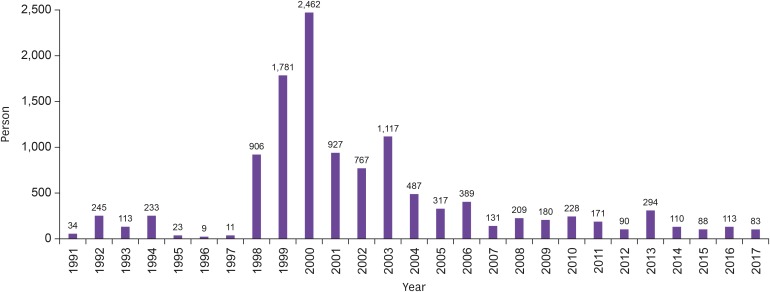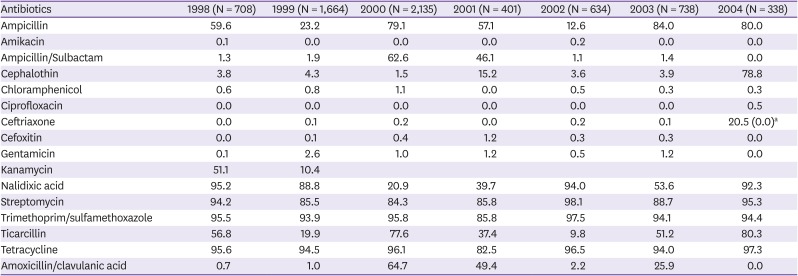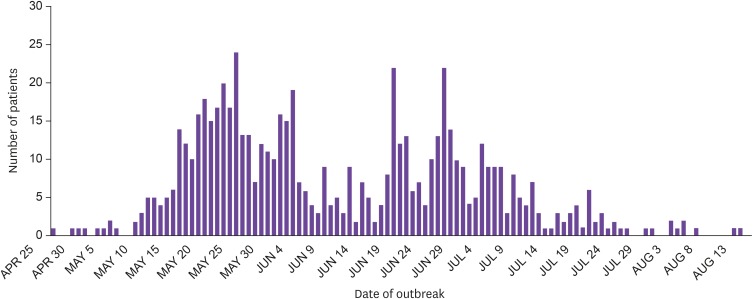1. Chun CH. Acute infectious disease overview. Seoul: Latest Medical History;1975.
2. Jwadeung. Dysentery (jeoklee) of Chosun dynasty. Guneuidan Magazine;1913.
3. Zimmerman LE, Cooper M, Graber CD. Bacteriologic studies in an epidemic of bacillary dysentery in Korea; serotypes of
Shigella and
Salmonella recovered and bacteriologic response to sulfadiazine, chloramphenicol, terramycin, aureomycin and streptomycin. Am J Clin Pathol. 1952; 22:549–557. PMID:
14933330.
4. Zimmerman LE. Some experiences with enteric diseases in Korea. Am J Public Health. 1953; 43:279–284.

5. Park S, Cho E. National infectious diseases surveillance data of South Korea. Epidemiol Health. 2014; 36:e2014030. PMID:
25420951.

7. Lee JC, Jeong YS, Oh JY, Kang HY, Kim KH, Kim J, Lee YC, Cho DT, Seol SY. Epidemiology of shigellosis in Korea. J Bacteriol Virol. 2006; 36:41–49.

8. Chun D. A review of Salmonella and Shigella in Korea. Endemic Dis Bull Nagasaki Univ. 1964; 6:125–138.
9. Chun D, Kim C, Ahn D, Lee J. Studies on Salmonella and Shigella isolated in Taegu area in Korea. Korean Choong Ang Med J. 1964; 5:249–254.
10. Chun D. Classification of dysentery bacilli and their prevalence in Korea. J Korean Med Assoc. 1970; 13:704–710.
11. Ahn D, Chun D. Studies on Shigella isolated in Taegu area in Korea. Korean Choong Ang Med J. 1962; 3:265–270.
12. Seol SY. Chunging patterns of serotypes and drug resistance of Salmonella and Shigella
. Kyungpook Med J. 1980; 21:245–249.
13. Kim KS, Oh JY, Jeong YW, Cho JW, Park JC, Cho DT, Lee JC. Epidemiological typing and characterization of dfr genes of Shigella sonnei isolates in Korea during the last two decades. J Microbiol Biotechnol. 2002; 12:106–113.
14. Oh JY, Yu HS, Kim SK, Seol SY, Cho DT, Lee JC. Changes in patterns of antimicrobial susceptibility and integron carriage among
Shigella sonnei isolates from southwestern Korea during epidemic periods. J Clin Microbiol. 2003; 41:421–423. PMID:
12517883.
15. Lee JC, Oh JY, Kim KS, Jeong YW, Cho JW, Park JC, Seol SY, Cho DT. Antimicrobial resistance of Shigella sonnei in Korea during the last decades. APMIS. 2001; 109:228–234. PMID:
11430501.
16. Chun BC. Epidemiological characteristics and effective management of re-emerging Shiegellosis. Ministry of Health and Welfare;2001.
17. Pai H. Bacillary dysentery. J Korean Med Assoc. 2003; 46:527–532.

18. Central epidemiological survey team. Jeju Island epidemiological survey team. Report by central epidemiological survey team on the Jeju Island bacillary dysentery group outbreak. 2000.
20. Kim HJ, Youn SK, Lee S, Choi YH. Epidemiological characteristics of imported shigellosis in Korea, 2010-2011. Osong Public Health Res Perspect. 2013; 4:159–165. PMID:
24159548.

21. Lee W, Chung HS, Lee H, Yum JH, Yong D, Jeong SH, Lee K, Chong Y. CTX-M-55-type extended-spectrum β-lactamase-producing
Shigella sonnei isolated from a Korean patient who had travelled to China. Ann Lab Med. 2013; 33:141–144. PMID:
23483349.
22. Kim JS, Kim JJ, Kim SJ, Jeon SE, Seo KY, Choi JK, Kim NO, Hong S, Chung GT, Yoo CK, Kim YT, Cheun HI, Bae GR, Yeo YH, Ha GJ, Choi MS, Kang SJ, Kim J. Outbreak of ciprofloxacin-resistant
Shigella sonnei associated with travel to Vietnam, Republic of Korea. Emerg Infect Dis. 2015; 21:1247–1250. PMID:
26079171.
23. Jeon YL, Nam YS, Lim G, Cho SY, Kim YT, Jang JH, Kim J, Park M, Lee HJ. Quinolone-resistant
Shigella flexneri isolated in a patient who travelled to India. Ann Lab Med. 2012; 32:366–369. PMID:
22950074.
24. DuPont HL. Shigella species (Bacillary dysentery). In : Mandell GL, Bennett JE, Dolin R, editors. Principles and practice of infectious diseases. 4th ed. New York: Churchill Livingstone;1995. p. 2033–2039.
25. The Korean Society of Infectious Diseases Korean Society for Chemotherapy and The Korean Society of Clinical Microbiology. Clinical Guideline for the Diagnosis and Treatment of Gastrointestinal Infections. Infect Chemother. 2010; 42:323–361.
26. Korea Center for Disease Control and Prevention. The outbreak of ESBL producing Shigella sonnei
. Communicable Diseases Monthly Report. 2005; 16:1–5.
27. Korea Centers for Disease Control and Prevention. National antimicrobial resistance monitoring status. Communicable Diseases Monthly Report. 2003; 14:273–282.
28. Chun BC. Public policy and laws on infectious disease control in Korea: past, present and prospective. Infect Chemother. 2011; 43:474–484.

29. Korea Centers for Disease Control and Prevention (KCDC). Case definitions for national notifiable infectious diseases, 2011. KCDC;2010.








 PDF
PDF ePub
ePub Citation
Citation Print
Print




 XML Download
XML Download